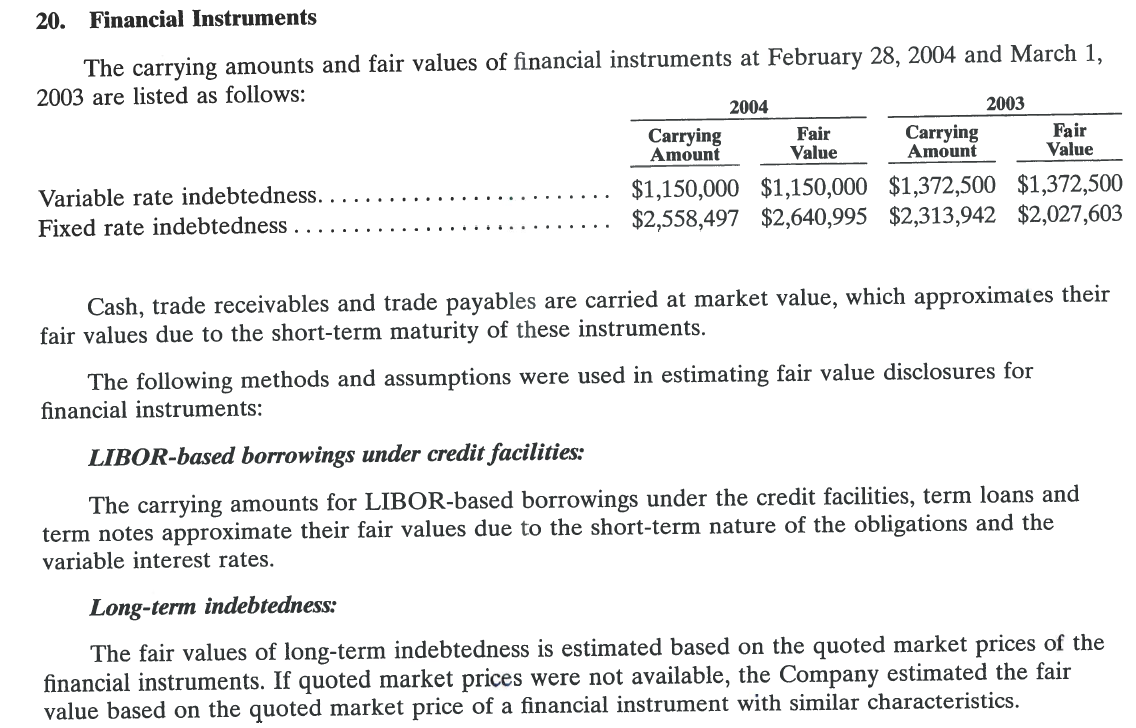Refer to Note 20, Financial Instruments. h. i What is the fair-value of Rite Aid's fixed-rate debt at February 28, 2004? Why does it differ from the carrying amount? What is the fair-value of the variable-rate debt at February 28, 2004? Why does it not differ from its carrying amount? ii iii Why would financial statement users want to know the fair-value of Rite Aid's debt? 20. Financial Instruments The carrying amounts and fair values of financial instruments at February 28, 2004 and March 1, 2003 are listed as follows: 2003 2004 Fair Value Carrying Amount Fair Value Carrying Amount $1,150,000 $1,150,000 $1,372,500 $1,372,500 $2,558,497 $2,640,995 $2,313,942 $2,027,603 Variable rate indebtedness Fixed rate indebtedness . Cash, trade receivables and trade payables are carried at market value, which approximates their fair values due to the short-term maturity of these instruments The following methods and assumptions were used in estimating fair value disclosures for financial instruments: LIBOR-based borrowings under credit facilities: The carrying amounts for LIBOR-based borrowings under the credit facilities, term loans and term notes approximate their fair values due to the short-term nature of the obligations and the variable interest rates Long-term indebtedness: The fair values of long-term indebtedness is estimated based on the quoted market prices of the financial instruments. If quoted market prices were not available, the Company estimated the fair value based on the quoted market price of a financial instrument with similar characteristics
Refer to Note 20, Financial Instruments. h. i What is the fair-value of Rite Aid's fixed-rate debt at February 28, 2004? Why does it differ from the carrying amount? What is the fair-value of the variable-rate debt at February 28, 2004? Why does it not differ from its carrying amount? ii iii Why would financial statement users want to know the fair-value of Rite Aid's debt? 20. Financial Instruments The carrying amounts and fair values of financial instruments at February 28, 2004 and March 1, 2003 are listed as follows: 2003 2004 Fair Value Carrying Amount Fair Value Carrying Amount $1,150,000 $1,150,000 $1,372,500 $1,372,500 $2,558,497 $2,640,995 $2,313,942 $2,027,603 Variable rate indebtedness Fixed rate indebtedness . Cash, trade receivables and trade payables are carried at market value, which approximates their fair values due to the short-term maturity of these instruments The following methods and assumptions were used in estimating fair value disclosures for financial instruments: LIBOR-based borrowings under credit facilities: The carrying amounts for LIBOR-based borrowings under the credit facilities, term loans and term notes approximate their fair values due to the short-term nature of the obligations and the variable interest rates Long-term indebtedness: The fair values of long-term indebtedness is estimated based on the quoted market prices of the financial instruments. If quoted market prices were not available, the Company estimated the fair value based on the quoted market price of a financial instrument with similar characteristics
Intermediate Financial Management (MindTap Course List)
13th Edition
ISBN:9781337395083
Author:Eugene F. Brigham, Phillip R. Daves
Publisher:Eugene F. Brigham, Phillip R. Daves
Chapter24: Enterprise Risk Management
Section: Chapter Questions
Problem 4P
Related questions
Question
see attached pictures for questions

Transcribed Image Text:Refer to Note 20, Financial Instruments.
h.
i
What is the fair-value of Rite Aid's fixed-rate debt at February 28, 2004? Why does it differ
from the carrying amount?
What is the fair-value of the variable-rate debt at February 28, 2004? Why does it not differ
from its carrying amount?
ii
iii
Why would financial statement users want to know the fair-value of Rite Aid's debt?

Transcribed Image Text:20. Financial Instruments
The carrying amounts and fair values of financial instruments at February 28, 2004 and March 1,
2003 are listed as follows:
2003
2004
Fair
Value
Carrying
Amount
Fair
Value
Carrying
Amount
$1,150,000 $1,150,000 $1,372,500 $1,372,500
$2,558,497 $2,640,995 $2,313,942 $2,027,603
Variable rate indebtedness
Fixed rate indebtedness .
Cash, trade receivables and trade payables are carried at market value, which approximates their
fair values due to the short-term maturity of these instruments
The following methods and assumptions were used in estimating fair value disclosures for
financial instruments:
LIBOR-based borrowings under credit facilities:
The carrying amounts for LIBOR-based borrowings under the credit facilities, term loans and
term notes approximate their fair values due to the short-term nature of the obligations and the
variable interest rates
Long-term indebtedness:
The fair values of long-term indebtedness is estimated based on the quoted market prices of the
financial instruments. If quoted market prices were not available, the Company estimated the fair
value based on the quoted market price of a financial instrument with similar characteristics
Expert Solution
This question has been solved!
Explore an expertly crafted, step-by-step solution for a thorough understanding of key concepts.
This is a popular solution!
Trending now
This is a popular solution!
Step by step
Solved in 3 steps

Knowledge Booster
Learn more about
Need a deep-dive on the concept behind this application? Look no further. Learn more about this topic, accounting and related others by exploring similar questions and additional content below.Recommended textbooks for you

Intermediate Financial Management (MindTap Course…
Finance
ISBN:
9781337395083
Author:
Eugene F. Brigham, Phillip R. Daves
Publisher:
Cengage Learning

Financial Reporting, Financial Statement Analysis…
Finance
ISBN:
9781285190907
Author:
James M. Wahlen, Stephen P. Baginski, Mark Bradshaw
Publisher:
Cengage Learning

Intermediate Financial Management (MindTap Course…
Finance
ISBN:
9781337395083
Author:
Eugene F. Brigham, Phillip R. Daves
Publisher:
Cengage Learning

Financial Reporting, Financial Statement Analysis…
Finance
ISBN:
9781285190907
Author:
James M. Wahlen, Stephen P. Baginski, Mark Bradshaw
Publisher:
Cengage Learning